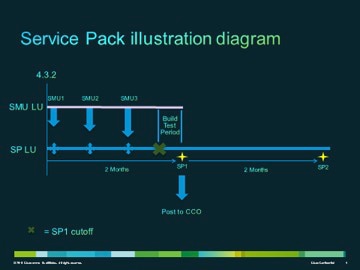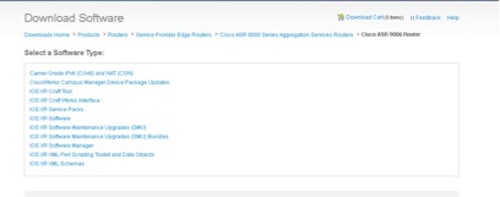Service Pack Overview for Routers that Run Cisco IOS XR
Available Languages
Contents
Introduction
This document describes Service Packs (SPs) for routers that run Cisco IOS® XR software.
Prerequisites
Requirements
Cisco recommends that you have knowledge of these topics:
- Cisco IOS XR Software Versions 4.3.2 and Later
- Cisco IOS XR Software Installation and Upgrade Procedures
Components Used
The information in this document is based on Cisco IOS XR software that is run on Cisco Aggregation Services Router (ASR) 9000 Series hardware.
The information in this document was created from the devices in a specific lab environment. All of the devices used in this document started with a cleared (default) configuration. If your network is live, make sure that you understand the potential impact of any command.
Related Products
This document can also be used with these hardware versions:
- Cisco ASR 9001
- Cisco ASR 9001-S
- Cisco ASR 9006
- Cisco ASR 9010
- Cisco ASR 9904
- Cisco ASR 9912
- Cisco ASR 9922
IOS XR SP Overview
An SP combines multiple Platform Dependent (PD) and Platform Independent (PI) Software Maintenance Updates (SMUs) into one package.
The goal of SPs is to reduce the independent SMU management overhead. An SP provides the same number of fixes through a single or small number of SP Package Installation Envelopes (PIEs).
Umbrella and Composite SMUs also provide multiple fixes in a single PIE and are common. They provide fixes that fall under a predefined boundary, which is typically PD fixes or PI fixes in a specific component. The 4.2.3 Composite SMU, C-SMU1, and C-SMU2 contain only PD fixes. A BGP Umbrella SMU contains only PI BGP component changes. SPs remove these boundaries and allow all of the PD and PI fixes to be delivered in a single package.
This diagram illustrates an overview of SPs when compared to regular SMUs:

Production SPs
SPs are formally developed, tested, and released on an average two-month interval on supported maintenance releases for Cisco IOS XR Software Versions 4.3.2 and later.
SP Behavior with Optional PIEs
SPs do not require all of the optional packages (MPLS or MGBL, for example) in order to be installed on the system. The only prerequisite is that Cisco IOS XR is installed.
Fixes for optional packages that are not installed do not become activated. In order to activate a fix for an optional package, the package must be installed prior to the SP or the optional PIE can be installed after SP installation. Use the admin show install active detail command in order to understand the optional PIEs for which the SP contains fixes.
In this example, the SP does not contain fixes for the Multicast (MCAST) PIE, so the PIE can be installed without trouble:
RP/0/RSP0/CPU0:ASR9K-PE3#admin show install active detail
disk0:asr9k-px-4.3.2.sp-1.0.0
disk0:asr9k-9000v-nV-supp-4.3.2.sp-1.0.0
disk0:asr9k-os-mbi-4.3.2.sp-1.0.0
disk0:iosxr-service-4.3.2.sp-1.0.0
disk0:asr9k-fpd-4.3.2.sp-1.0.0
disk0:iosxr-mgbl-4.3.2.sp-1.0.0
disk0:iosxr-mpls-4.3.2.sp-1.0.0
disk0:asr9k-fwding-4.3.2.sp-1.0.0
disk0:iosxr-routing-4.3.2.sp-1.0.0
disk0:iosxr-infra-4.3.2.sp-1.0.0
disk0:asr9k-base-4.3.2.sp-1.0.0
SP Restart Types
SPs have restart types, which are always set to Reload Required.
Each SP has a readme.txt file that documents the content, the impact of the SMU, the Distributed Defect Tracking Systems (DDTSs) that are included, and the other SPs that are superseded.
Use the admin show install package <sp-package> command after the SP is installed, or the admin show install pie-info <sp-pie> command on the SP PIE prior to an Install Add of the SP PIE, in order to to identify the SP content.
SP Naming Conventions
An SP consists of the binary file and its associated readme.txt file, which contains any associated caveats. Examples include:
- asr9k-px-4.3.2.sp-1.0.0.pie
- asr9k-px-4.3.2.sp-1.0.0.txt
- asr9k-px-4.3.2.sp-1.0.0.tar
The naming convention follows the platform-type-release-SP-version-file format:
- Platform: asr9k (ASR 9000)
- Image Type: px
- Release: 4.3.2 (for example)
- File formats:
- .pie
- .txt
- .tar
Download SMUs from CDC
SPs are located in the Download Software Center on Cisco.com (CDC).
Complete these steps in order to download SPs:
- Navigate to the Download Software Center and then to the router platform type.
- Navigate to Downloads Home > Products > Routers > Service Provider Edge Routers > Cisco ASR 9000 Series Aggregation Services Routers > Cisco ASR 9006 Router.
- Select IOS XR Service Packs.

SMU Delivery Timelines
SPs are delivered approximately every eight to ten weeks for the life of a release.
SMU Supercedes and Prerequisites
This section describes the SMU supercedes and prerequisites.
Supercedes
It is important to understand that SPs are committed to an SP software lineup (LU) that is particular to the release, which is different from the SMU LU for the same release. Hence, it is a challenge for an SMU to be deployed on top of an SP without careful consideration of the SMU build process; the SMU metadata must be programed with knowledge of the SP.
SPs are cumulatively built, and every new SP release fully supercedes the prior SPs for a given release. A newer SP for a release can be installed without installation of the previous SPs for that release. Also, SPs can be installed on top of each other without any problems, even if there are some gaps in the SP versions.
Here are two techniques that are used in order to identify SP supercedes:
- Check the readme.txt file that comes with the SP.
- Use the Cisco Software Manager (CSM).
Prerequisites
SPs for all releases prior to 5.1.1 Require a pre-requiste SMU (CSCul58246) to be installed, as well as of its pre-requisites so that the system understands the Service Pack PIE. In 5.1.1 this information is already in the base code, hence a pre-requisite smu is not required.
SP Installation
Complete these three operational steps in order to apply an SP:
- Enter the install add admin command in order to add the SP to the file system.
- Enter the install activate admin command in order to activate the SP on the system.
- Enter the install commit admin command in order to commit the SP change so that it is persistent across reloads.
Example Install Add Activate Operation
This example provides an alternative SP installation method.
RP/0/RSP0/CPU0:ASR9K-PE3(admin)#install add
disk0:/asr9k-px-4.3.2.sp-1.0.0.pie activate
Fri Feb 7 14:01:31.675 UTC
Install operation 37 '(admin) install add /disk0:/asr9k-px-4.3.2.sp-1.0.0.pie
activate' started by user 'cisco' via CLI at 14:01:31
UTC Fri Feb 07 2014.
Part 1 of 2 (add software): Started
The install operation will continue asynchronously.
RP/0/RSP0/CPU0:ASR9K-PE3(admin)#
Install operation 37 '(admin) install add /disk0:/asr9k-px-4.3.2.sp-1.0.0.pie
activate' started by user 'cisco' via CLI at 14:01:31
UTC Fri Feb 07 2014.
Part 1 of 2 (add software): Started
Info: The following package is now available to be activated:
Info:
Info: disk0:asr9k-px-4.3.2.sp-1.0.0
Info:
Info: The package can be activated across the entire router.
Info:
Part 1 of 2 (add software): Completed successfully
Part 2 of 2 (activate software): Started
Info: This operation will reload the following nodes in parallel:
Info: 0/RSP0/CPU0 (RP) (SDR: Owner)
Info: 0/0/CPU0 (LC) (SDR: Owner)
Info: 0/1/CPU0 (LC) (SDR: Owner)
Info: 0/2/CPU0 (LC) (SDR: Owner)
Info: 0/3/CPU0 (LC) (SDR: Owner)
Info: Install operation 37 is paused as the user must answer a question.
Info: Please continue the operation using one the following steps:
Info: - run the command '(admin) install operation 37 attach
synchronous'and then answer the query.
Info: - run the command '(admin) install attach 37'
and then answer the query.
Proceed with this install operation (y/n)? [y]
Info: Install Method: Parallel Reload
Info: The changes made to software configurations will not be persistent
across system reloads. Use the command '(admin)
Info: install commit' to make changes persistent.
Info: Please verify that the system is consistent following the software
change using the following commands:
Info: show system verify
Info: install verify packages
Part 2 of 2 (activate software): Completed successfully
Part 1 of 2 (add software): Completed successfully
Part 2 of 2 (activate software): Completed successfully
Install operation 37 completed successfully at 14:04:15 UTC Fri Feb 07 2014.
RP/0/RSP0/CPU0:ASR9K-PE3(admin)#
RP/0/RSP0/CPU0:ASR9K-PE3#show install active summary
Sat Feb 8 05:15:55.981 UTC
Default Profile:
SDRs:
Owner
Active Packages:
disk0:asr9k-mini-px-4.3.2
disk0:asr9k-px-4.3.2.sp-1.0.0
If needed, you can install SP3 on top of the previous system, which has SP1. The output from the show install active summary command only shows SP3 as the active SP. Here is an example:
RP/0/RSP0/CPU0:ASR9K-PE3#show install active summary
Sat Feb 8 05:15:55.981 UTC
Default Profile:
SDRs:
Owner
Active Packages:
disk0:asr9k-mini-px-4.3.2
disk0:asr9k-px-4.3.2.sp-3.0.0
SMU Management
The CSM provides Cisco IOS XR SMU and SP recommendations to users and reduces the effort that it takes in order to manually search, identify, and analyze SMUs that are needed for a device. The CSM can connect to multiple devices and provide SMU and SP management for multiple Cisco IOS XR platforms and releases.
The CSM is a standalone application that can be installed on Microsoft Windows, Macintosh (MAC), and UNIX systems. The CSM supports the Cisco Carrier Routing System (CRS) and Cisco ASR 9000 Series devices.
Refer to the Cisco Software Manager User Guide for more information.
Revision History
| Revision | Publish Date | Comments |
|---|---|---|
1.0 |
21-Apr-2016 |
Initial Release |
Contact Cisco
- Open a Support Case

- (Requires a Cisco Service Contract)
 Feedback
Feedback